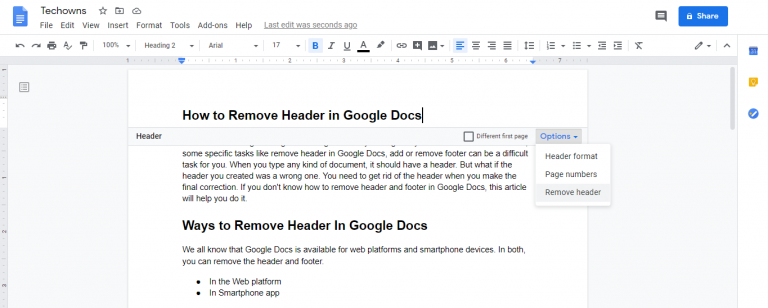
Step 3: On the dropdown menu that appears, click the “Headers & Footers” option. Step 2: After activating the footer options, select “Format” on the menu bar. Just make sure that the “Different first page” box is ticked. Here, you can opt to have different formatting for every footer in the document by ticking the “Different first page” box.īut, you can also tick the “Different odd and even” box if you want the odd-paged footers to have a different format from the even-paged ones. Step 7: After adjusting the margins of your header, head to the “Layout” category. Type a larger number if you want to make the footer farther from the bottom, and a smaller number if you want to make your footer nearer the footer of the page. Step 6: Now, if you want to edit how far the footer is from the bottom of the page, head to the “Margins” category and edit the number in the box next to the “Footer” section. Since you want to apply the formatting to the entire document, select the “Whole document” option. Then, in the dropdown menu, select whether you want to apply the formatting to the “Whole document,” “This section (Section _),” or “This section forward.” Step 5: On the pop-out window, head to the “Apply to” section first. You can also activate the same window by clicking “Format” in the menu tab and selecting the “Headers and Footers” option. Then, select “Footer format.” You’ll then see a pop-out window appear at the center of the screen. Step 1: Open a Google Docs document or create one by clicking the “Blank” template from docs.new page.Īfter accessing the file or typing on the document, scroll down until you reach the page where you want to create a separate footer. If you want to have a different footer per page of your Google Docs document, follow these key steps: This means that whatever change you create on the previous page affects the next pages in the document.

Once the cursor appears on the next page, scroll down and double-click on the footer section.On the second dropdown menu that appears, click “Section break (next page).”.Keep scrolling until the “Break” option in the dropdown menu appears and click the “>” button.Head to the menu bar and select the “Insert” tab.After locating that particular page, place the cursor after the last word or sentence of the previous page.After opening the Google Docs document, scroll down to the page where you want to create a different footer.

#DELETE HEADERS G DOCS HOW TO#
How to Have Different Footers in Google Docs default // Make a request for a user with a given ID axios. Client side support for protecting against XSRFĬonst axios = require ( 'axios' ).🆕 Automatic data object serialization to multipart/form-data and x-www-form-urlencoded body encodings.Using application/x-www-form-urlencoded format.New axios docs website: click here Table of Contents Promise based HTTP client for the browser and node.js Axios Table of Contents Features Browser Support Installing Example note: CommonJS usage axios API axios(config) axios(url) Request method aliases axios.request(config) axios.get(url) lete(url) axios.head(url) axios.options(url) axios.post(url]) axios.put(url]) axios.patch(url]) NOTE Concurrency (Deprecated) Creating an instance axios.create() Instance methods axios#request(config) axios#get(url) axios#delete(url) axios#head(url) axios#options(url) axios#post(url]) axios#put(url]) axios#patch(url]) axios#getUri() Request Config Response Schema Config Defaults Global axios defaults Custom instance defaults Config order of precedence Interceptors Multiple Interceptors Handling Errors Cancellation AbortController CancelToken 👎deprecated Using application/x-axios


 0 kommentar(er)
0 kommentar(er)
